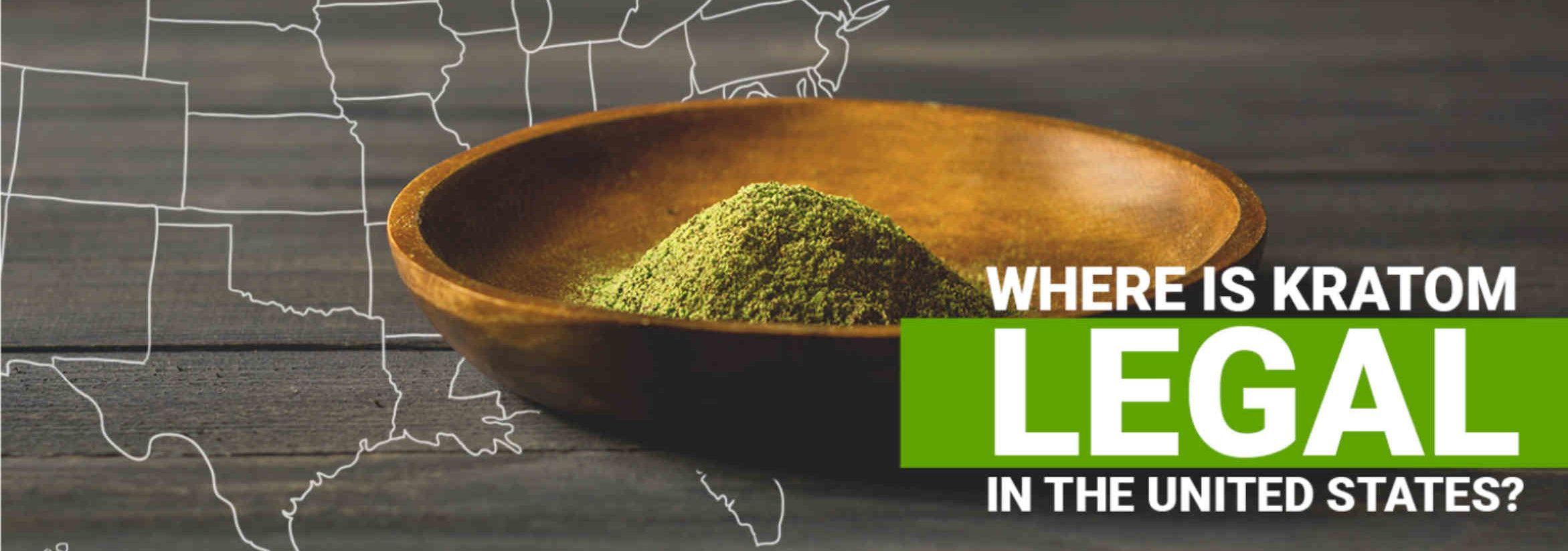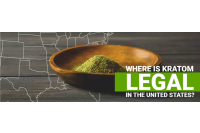

Amidst the increasing popularity of kratom products in the United States, individuals often find themselves uncertain about the legal status of kratom in their respective states or cities. Rest assured, you are not alone in grappling with this uncertainty. The online landscape is filled with articles that present varying perspectives on kratom, creating a sense of confusion for many.
To make an informed decision regarding the purchase of kratom, it is crucial to equip yourself with knowledge about this botanical substance. If you are unfamiliar with kratom, I recommend reading our comprehensive article titled "What is Kratom?"
In the forthcoming discussion, we will explore the legal status of kratom in different states, cities, and counties. It's essential to note that kratom is not universally legal across all 50 states in the United States. Delving into the specifics of legality will provide valuable insights for those considering purchasing kratom, whether online or from a local store in their vicinity.
Kratom Legality in the USA
For centuries, kratom has been an integral part of South East Asian cultures, valued for its diverse properties including stimulation, sedation, and medicinal uses. Derived from the leaves of a native tropical tree, its introduction to the United States can be traced back to its utilization by soldiers during the Vietnam War and the subsequent influx of immigrants from South East Asia in the sixties and seventies. If you're curious about the legal status of kratom in the United States, let's delve into that.
In lower doses, kratom acts as a stimulant, while higher doses are reputed to induce a calming effect, drawing parallels with certain aspects of cannabis. In the United States, kratom is available in various forms such as powder, resin, and capsules. It is commonly ingested by blending it with beverages or food items, such as tea or yogurt.
When incorporating kratom into your routine, it's essential to procure it from a reputable source, ensuring its purity, natural state, and absence of adulteration. This approach is crucial for a safe and authentic experience with this ancient botanical substance.
Potential Benefits and Risks of Kratom
While advocates of kratom commend its mind-altering, mood-enhancing, and discomfort relief properties, critics highlight potential side effects and associated risks. While a significant number of users may not experience adverse effects or may only encounter mild discomfort, there are reported cases of nausea, hallucinations, and seizures linked to kratom use. Detractors also express concerns about the potential for addiction, dependence, and abuse, suggesting that kratom could serve as a gateway to more potent and hazardous substances. It is essential to consider both perspectives when evaluating the benefits and risks associated with kratom consumption.
Kratom Legal Status Map - State By State
The legal status of kratom varies across different states in the United States. Presently, kratom is legal in 44 states and in Washington DC; however, in seven of these states, it is subject to specific restrictions, limitations, and some localized bans at the county, city, or town level.
Conversely, kratom is currently banned in six American states. Before purchasing kratom, it is crucial to check the legal status in your specific state. It's noteworthy that certain counties, cities, and towns may have implemented their bans, even in states where kratom is legally permitted.
Additionally, some states have restrictions on selling kratom to minors. When ordering online or transporting kratom across state lines, it's essential to be aware of the legal regulations in the respective states.
Several states have enacted or are actively considering the Kratom Consumer Protection Act. This legislation places obligations on vendors to adhere to regulations covering packaging, product testing, manufacturing, distribution, sales, and other aspects. This development is seen as a sensible and positive step for various stakeholders, including vendors, users, distributors, manufacturers, regulators, and legislators.
It's important to note that legislation both for and against kratom is pending in several states. Staying informed about the latest developments by checking with your local legislature is advisable.
States Where Kratom Status Is Legal In the USA
| Alaska
Kratom is fully legal in Alaska, and no legislation is pending as of late 2020. |
| Arizona
Kratom is fully legal in Arizona. There was a proposal to ban kratom in 2014, but it was defeated. In 2019, Arizona passed the Kratom Consumer Protection Act. |
| California (With Some Restrictions)
Kratom is legal everywhere in California apart from San Diego, where a bill to ban it was passed in 2016. |
| Colorado (With Some Restrictions)
For the most part, kratom is essentially legal in Colorado. However, the sale of kratom for “human consumption” is banned in Denver, and sales are also banned or restricted in several other towns. |
| Connecticut
The status of Kratom is fully legal in Connecticut, and no legislation is pending as of late 2020. |
| Delaware
Kratom is fully legal in Delaware, and no legislation is pending as of late 2020. |
| Florida (With some restrictions)
Kratom is legal in Florida apart from in Sarasota County, which banned sales of Kratom in 2014, citing concerns about potential addiction and it is a gateway drug. |
| Georgia
A bill to ban kratom in 2018 was defeated. In 2020, Georgia became the third state to ratify the Kratom Consumer Protection Act, which was passed unanimously. |
| Hawaii
Kratom is fully legal in Hawaii, but as of late 2020, legislation to ban or restrict sales is pending. |
| Idaho
Kratom is fully legal in Idaho, but as of late 2020, legislation is pending on labeling, vendor registration, and sales to minors. |
| Illinois (With some restrictions)
Kratom is legal for people aged over 18 except in Jerseyville City and Alton. As of late 2020, legislation is pending to amend the Illinois Controlled Substances Act, list kratom as a Schedule II drug, and also repeal the Kratom Control Act. However, the state is also considering the implementation of the Kratom Consumer Protection Act. |
| Iowa
Kratom is fully legal in Iowa, and no legislation is pending as of late 2020. In 2014, a bill to ban Kratom was defeated. |
| Kansas
Kratom is fully legal in Kansas. In 2018, a move to criminalize Kratom was defeated. As of late 2020, Kansas is reviewing the Kratom Consumer Protection Act. |
| Kentucky
Kratom is fully legal in Kentucky. Several bills to outlaw kratom in the state have been defeated over the years, but as of late 2020, some legislators are still pushing for a ban. |
| Louisiana
Despite numerous attempts to ban it, Kratom Status remains fully legal in Louisiana. In 2019, a bill was passed to ban kratom if the DEA schedules it. As of late 2020, legislation is pending regarding the distribution of kratom products. |
| Maine
Kratom is fully legal in Maine. In 2017, a bill to ban kratom did not pass. As of late 2020, Maine is considering the Kratom Consumer Protection Act. |
| Maryland
Kratom is fully legal in Maryland. However, as of late 2020, there is pending legislation to ban kratom. |
| Massachusetts
Kratom is fully legal in Massachusetts, and no legislation is pending as of late 2020. |
| Michigan
Several attempts have been made in the past to ban Kratom, but it remains fully legal in Michigan. However, as of late 2020, legislation is pending to make kratom a Schedule II drug. |
| Minnesota
Kratom is fully legal in Minnesota, although it is an offense to sell the drug to minors. No legislation is pending as of late 2020. |
| Mississippi (With some Restrictions)
Kratom is banned in a long list of counties and cities in Mississippi, with further debate else where in the state. However, various attempts to ban it state-wide have been unsuccessful. |
| Missouri
Kratom is fully legal in Missouri. In 2020, legislators unanimously implemented the Kratom Consumer Protection Act, although some counties continue to contemplate a ban. |
| Montana
Kratom is fully legal in Montana, and no legislation is pending as of late 2020. |
| Nebraska
Kratom is fully legal in Nebraska, and no legislation is pending as of late 2020. |
| Nevada
Kratom is fully legal in Nevada, and no legislation is pending as oflate 2020. In 2019, legislators passed the Kratom Consumer Protection Act. |
| New Hampshire (With some restrictions)
Outside of Franklin City, Kratom is fully legal for over 18s in New Hampshire. In 2020, a bill to ban kratom failed to pass. |
| New Jersey
Kratom is fully legal in New Jersey. Several unsuccessful attempts have been made to ban kratom, and those efforts are ongoing as of late 2020. |
| New Mexico
Kratom is fully legal in New Mexico, and no legislation is pending as of late 2020. |
| New York
Kratom is fully legal in New York, and multiple bills to ban it have failed. As of late 2020, legislators are considering the implementation of the Kratom Consumer Protection Act, and also the prohibition of sales to minors. |
| North Carolina
Kratom is fully legal in North Carolina for over 18s, and no legislation is pending as of late 2020. A bill to ban kratom in 2016 was unsuccessful. |
| North Dakota
Kratom is fully legal in North Dakota, and no legislation is pending as of late 2020. |
| Ohio
Kratom is fully legal in Ohio. A bid in 2019 by the Ohio Board of Pharmacy to make kratom a Schedule 1 drug was deferred, and as of late 2020, but now legislators are considering a version of the Kratom Consumer Protection Act. |
| Oklahoma
Kratom is fully legal in Oklahoma. In 2014, a bill to ban kratom failed. As of late 2020, legislators are considering the Kratom Consumer Protection Act. |
| Oregon
Kratom is fully legal in Oregon. As of late 2020, legislators are considering the Kratom Consumer Protection Act. |
| Pennsylvania
Kratom is fully legal in Pennsylvania. As of late 2020, legislators are considering a version of the Kratom Consumer Protection Act. |
| South Carolina
Kratom is fully legal in South Carolina. As of late 2020, legislators are considering a version of the Kratom Consumer Protection Act. |
| South Dakota
Kratom is fully legal in South Dakota. In 2020, a bill to ban kratom was defeated, and legislators are now reviewing the Kratom Consumer Protection Act. |
| Tennessee (With some restrictions)
Kratom in its natural form is fully legal in Tennessee, and no legislation is pending as of late 2020. The sale of kratom to under 21s is forbidden. In 2014, a bill banning several synthetic substances was passed, but also the state attorney general subsequently ruled that kratom in its natural form was not on the list of banned substances. |
| Texas
Kratom is fully legal in Texas. In 2023 Texas passed the Kratom Consumer Protection Act (KCPA) bill. |
| Utah
Kratom is fully legal in Utah. In 2019, Utah became the first state to formally regulate the drug when it passed the Kratom Consumer Protection Act. |
| Virginia
Kratom is fully legal in Virginia. In early 2020, legislators commissioned the Virginia Board of Pharmacy to conduct a study on whether kratom should be classified as a controlled substance. The results of the study will be discussed in 2021. |
| Washington
Kratom is fully legal in Washington, and no legislation is pending as of late 2020. |
| West Virginia
Kratom is fully legal in West Virginia, and no legislation is pending as of late 2020. In 2018, a bill to ban kratom was defeated. |
| Wyoming
Kratom is fully legal in Wyoming, and no legislation is pending as of late 2020. |
| Washington, DC
Kratom was initially banned in DC in 2016, but when the controlled substance act was amended in 2019, it was removed from the list. |
US States Where Kratom is illegal or Banned
| Alabama
Kratom has been outlawed in Alabama since 2016. The relevant bill did not expressly prohibit kratom, but it did include a ban on the alkaloids hydromitragynine and mitragynine. Since both these elements are present in kratom, the bill effectively banned its sale and usage. |
| Arkansas
Kratom has been banned outright in Arkansas since 2015. It is classed as a Schedule 1 drug, and also there are heavy penalties if you buy, possess, or sell kratom. |
| Indiana
Kratom has been banned in Indiana since as far back as 2004. |
| Rhode Island
Kratom is banned in Rhode Island. However, as of late 2020, legislation is pending to regulate the distribution of kratom. |
| Vermont
Kratom is illegal in Vermont, thanks to a ban on the alkaloid hydromitragynine, which is a constituent part of the drug. As of late 2020, legislation is pending to reverse the ban and legalize kratom. |
| Wisconsin
Kratom has been banned in Wisconsin since 2014. In 2019, legislators held a public hearing about kratom, and there are indications that they might bring forward a bill to enact the Kratom Consumer Protection Act. |
More information about legal status of Kratom in the United States
For anyone interested in learning more about or even joining the campaign to legalize kratom, several useful sites are listed below. If you have strong feelings either way about the legal status of kratom, it is important to make them known to your political representatives.
- www.americankratom.org: the American Kratom Association is a consumer advocacy group that champions the rights of users to enjoy kratom across the USA.
- www.legiscan.com: a simply fantastic resource to check on all legislation in your state, including, but not limited to, the legal status of kratom.
- www.house.gov and www.senate.gov: use these websites to find and contact your political representatives.
Conclusion
There is currently no definitive information as to the potential benefits or health risks of kratom, and more academic research is urgently required in this area.
On one side of the argument are the millions of Kratom users who are convinced of the benefits and value of this drug.
They are directly supported by many medical professionals, and also indirectly by the number of US states and countries worldwide who have chosen not to ban kratom.
On the other hand, other medical professionals, government agencies like the FDA (Food & Drug Administration) and DEA (Drug Enforcement Administration), six US states and many countries worldwide remain suspicious of kratom.
Opponents cite negative side-effects like health ailments, the dangers of addiction and kratom’s alleged potential as a gateway drug.
In the absence of definitive evidence either way, for the moment, the jury must remain out.
But we might note in passing that many of the negative assertions about kratom and were also levelled at cannabis, a once banned drug that is now being legalized in an increasing number of US states and countries.
And it surely speaks volumes that kratom remains legal in so many states and countries.



